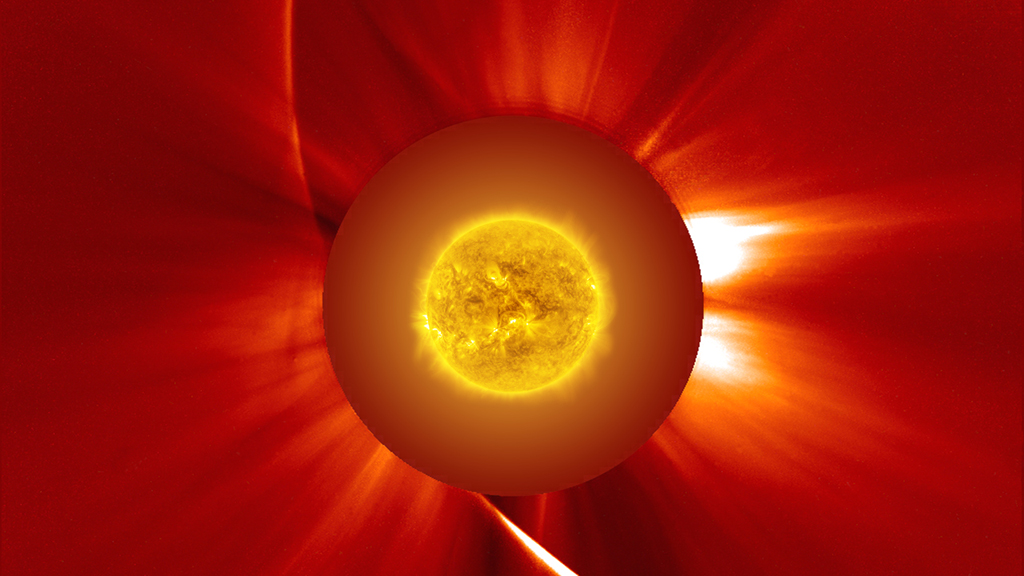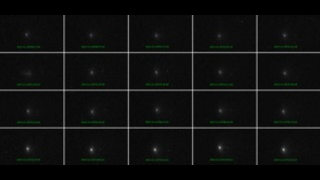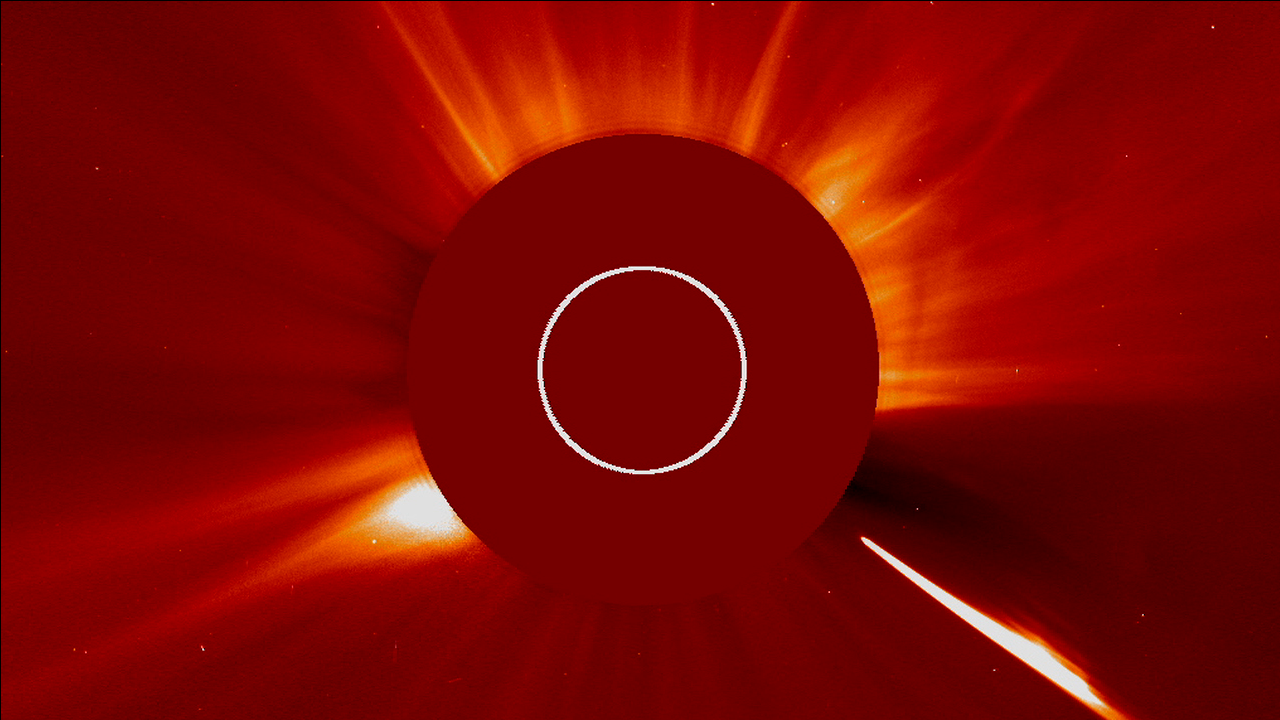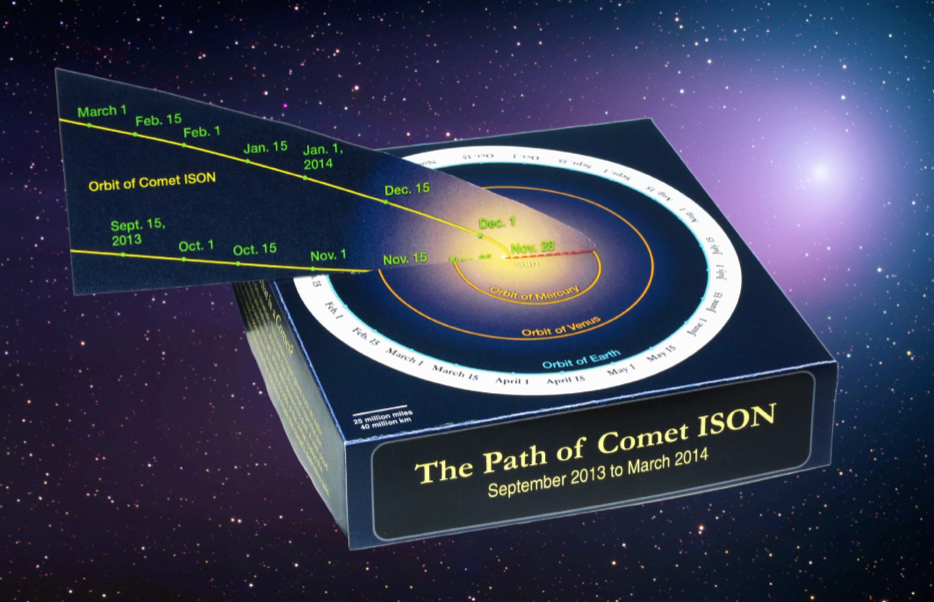NASA's Solar Observing Fleet Watch Comet ISON's Journey Around the Sun
After several days of continued observations, scientists continue to work to determine and to understand the fate of Comet ISON: There's no doubt that the comet shrank in size considerably as it rounded the sun and there's no doubt that something made it out on the other side to shoot back into space. The question remains as to whether the bright spot seen moving away from the sun was simply debris, or whether a small nucleus of the original ball of ice was still there. Regardless, it is likely that it is now only dust. The comet was visible in instruments on NASA's Solar Terrestrial Relations Observatory, or STEREO, and the joint European Space Agency/NASA Solar and Heliospheric Observatory, or SOHO, via images called coronagraphs.
Watch this video on the NASA Goddard YouTube channel.
Credit:NASA/STEREO/ESA/SOHO/SDOGSFC

"Timelapse" series of images of comet ISON as viewed by ESA/NASA's Solar and Heliospheric Observatory, or SOHO. This image is a composite, with the sun imaged by NASA's Solar Dynamics Observatory in the center, and SOHO's two coronagraphs showing the solar atmosphere, the corona. The most recent image in this is from 6:30 a.m. EST on Dec. 1, 2013.
Image Credit:ESA&NASA/SOHO/SDO

Comet ISON swoops around the sun and through Scorpius. This composite merges an SDO AIA 171 sun image (Nov. 28, 2214 UT), SOHO C2 (2036 UT) and C3 (2030 UT) images, and a Digitized Sky Survey view of the sky in northern Scorpius.
Credit: NASA/ESA/SOHO, NASA/SDO, DSS, and Francis Reddy

This view captures the transformation of Comet ISON as it rounded the sun. It combines 60 SOHO C2 frames in which ISON appears (Nov. 28, 1248 UT, to Nov. 29, 0316 UT) with stars, noise and particle tracks removed, plus an SDO AIA 171 image of the sun taken just before the spacecraft attempted to image the comet near perihelion.
Credit: NASA/ESA/SOHO, NASA/SDO, and Francis Reddy

A series of images from ESA/NASA's Solar and Heliospheric Observatory, or SOHO, showing what remains of comet ISON as it continues its orbit.
Credit: ESA&NASA/SOHO

A series of images from ESA/NASA's Solar and Heliospheric Observatory, or SOHO, showing what remains of comet ISON as it continues its orbit.
Credit: ESA&NASA/SOHO

"Timelapse" series of images of comet ISON as viewed by ESA/NASA's Solar and Heliospheric Observatory, or SOHO. The most recent image in this is from 5:30 p.m. EST on Nov. 29, 2013.
Image Credit:ESA&NASA/SOHO
These images from NASA's Solar Terrestrial Relations Observatory and the ESA/NASA Solar and Heliospheric Observatory show Comet ISON growing dim as it made the journey around the sun. The comet is believed to have broken up and evaporated.
Watch this video on the NASA Goddard YouTube channel.
Credit: NASA/STEREO/ESA/SOHO/GSFC

Comet ISON has moved quite close to the sun in this image from ESA/NASA's Solar and Heliospheric Observatory captured at 10:51 a.m. EST on Nov. 28, 2013. This image is a composite, with the sun imaged by NASA's Solar Dynamics Observatory in the center, and SOHO showing the solar atmosphere, the corona.
Image Credit:
ESA&NASA/SOHO/SDO

Comet ISON moves ever closer to the sun in this image from ESA and NASA's Solar and Heliospheric Observatory, or SOHO, captured at 9:30 a.m. EST on Nov. 28, 2013. This image is a composite, with the sun imaged by NASA's Solar Dynamics Observatory, or SDO, in the center, and SOHO showing the solar atmosphere, the corona.
Credit: ESA&NASA/SOHO/SDO
ISON enters the field of view of the joint ESA/NASA Solar and Heliospheric Observatory, or SOHO, spacecraft's C3 coronograph, where the brighter view of the sun itself is blocked to focus on the solar atmosphere, or corona. This video covers 17 hours beginning at 19:42 UT on Nov. 26, 2013.
Watch this video on the NASAgovVideo YouTube channel.
Credit: ESA&NASA/SOHO/GSFC
ISON enters the field of view of the joint ESA/NASA Solar and Heliospheric Observatory, or SOHO, spacecraft's C3 coronograph, where the brighter view of the sun itself is blocked to focus on the solar atmosphere, or corona. This video covers 17 hours beginning at 19:42 UT on Nov. 26, 2013. Full-resolution, full-field frames, video at 6fps and still.
Credit: ESA&NASA/SOHO
NASA's STEREO-A spacecraft continues to observe Comet ISON as it approaches the sun. This movie from the spacecraft's Heliospheric Imager shows Comet ISON, Mercury, Comet Encke and Earth over a five day period from Nov. 20 to Nov. 25, 2013. The sun sits right of the field of view of this camera. This version is enhanced, resized and cropped for HD.
Watch this video on the NASAgovVideo YouTube channel.
Credit: NASA/NRL/STEREO/CIOC/GSFC.
NASA's STEREO-A spacecraft continues to observe Comet ISON as it approaches the sun. This movie from the spacecraft's Heliospheric Imager shows Comet ISON, Mercury, Comet Encke and Earth over a five day period from Nov. 20 to Nov. 25, 2013. The sun sits right of the field of view of this camera. This is the full-resolution, full field-of-view. It covers the same time period as the video above and has a time stamp.
Credit: NRL/NASA STEREO/CIOC.
Cropped and enlarged footage from the STEREO A Hi 1 sensor covering Nov 21 at 0:39UT to Nov 25 at 15:19 UT.The sun sits right of the field of view of this camera.
Credit: Nathan Rich/NRL/NASA STEREO/CIOC.
NASA's STEREO-A spacecraft is monitoring Comet ISON as it approaches the sun. The latest movie from the spacecraft's Heliospheric Imager shows Comet ISON, Mercury, Comet Encke and Earth over a two day period from Nov. 20 to Nov. 22, 2013. The sun sits right of the field of view of this camera.
Image Credit: Karl Battams/NRL/NASA STEREO/CIOC.

This still image from the video shows comet ISON just passing the plane of Mercury, with Comet Encke ahead and slightly above on Nov. 22, 2013. The sun is off-screen to the right. The wave-like shape on the right is a coronal mass ejection (CME.)
Image Credit:Karl Battams/NRL/NASA STEREO/CIOC

Comet C/2012 S1 (ISON) has entered the NASA STEREO/SECCHI HI-1A field of view where it joins the Earth, Mercury and comet 2P/Encke.
Credit: Karl Battams/NASA/STEREO/CIOC
Comet ISON makes its appearance into the higher-resolution HI-1 camera on the STEREO-A spacecraft. The dark "clouds" coming from the right are density enhancements in the solar wind, causing all the ripples in comet Encke's tail. These kinds of solar wind interactions give us valuable information about solar wind conditions near the sun. Note: the STEREO-A spacecraft is currently located on the other side of the Sun, so it sees a totally different geometry to what we see from Earth.
Credit: Karl Battams/NASA/STEREO/CIOC
For More Information
Credits
Please give credit for this item to:
NASA's Goddard Space Flight Center. However, individual images should be credited as indicated above.
-
Video editor
- Scott Wiessinger (USRA)
-
Producer
- Scott Wiessinger (USRA)
-
Scientist
- Karl Battams (Naval Research Laboratory)
-
Writer
- Karen Fox (ADNET Systems, Inc.)
Release date
This page was originally published on Friday, November 22, 2013.
This page was last updated on Wednesday, May 3, 2023 at 1:51 PM EDT.



